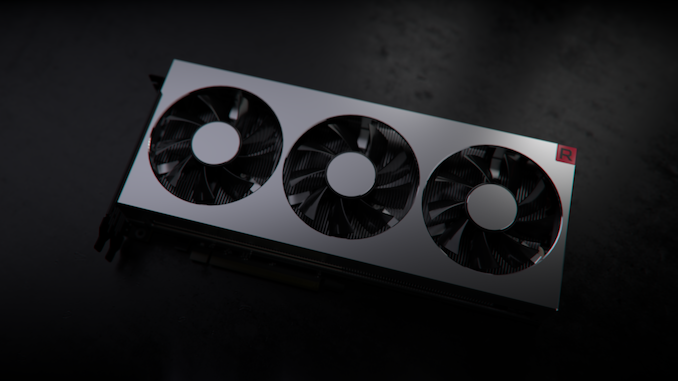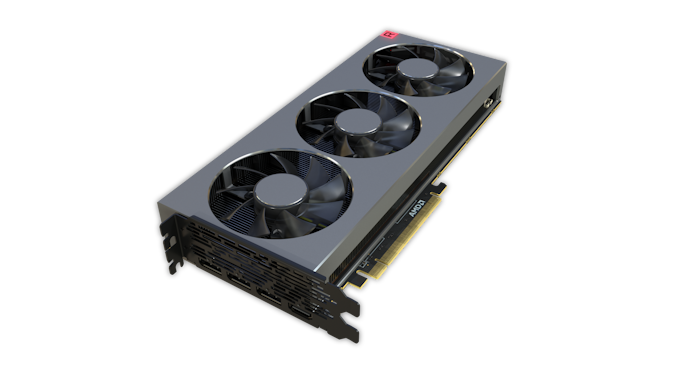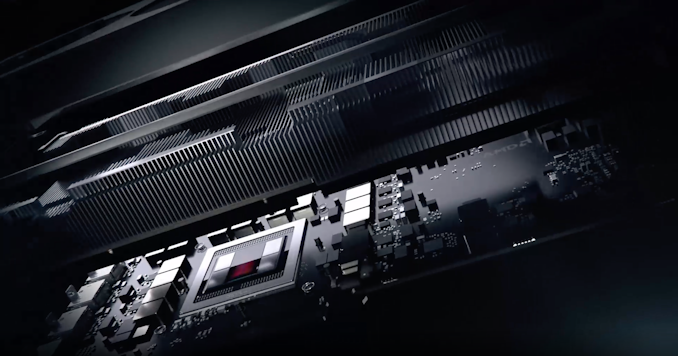The AMD Radeon VII Review: An Unexpected Shot At The High-End
by Nate Oh on February 7, 2019 9:00 AM ESTMeet The Radeon VII
First things first is the design and build, and for the AMD Radeon VII, we've already noticed the biggest change: an open air cooler. Keeping the sleek brushed metal look of the previous RX Vega 64 Limited Edition and Liquid variants, they've forgone the blower for a triple axial fan setup, the standard custom AIB configuration for high-end cards.
While NVIDIA's GeForce RTX series went this way with open-air dual-fan coolers, AMD is no stranger to changing things up themselves. Aside from the RX Vega 64 Liquid, the R9 Fury X's AIO CLC was also quite impressive for a reference design. But as we mentioned with the Founders Edition cards, moving away from blowers for open-air means adopting a cooling configuration that can no longer guarantee complete self-cooling. That is, cooling effectiveness won't be independent of chassis airflow, or lack thereof. This is usually an issue for large OEMs that configure machines assuming blower-style cards, but this is less the case for the highest-end cards, which for pre-builts tend to come from boutique system integrators.
The move to open-air does benefit higher TDP, and at 300W TBP the Radeon VII is indeed one for higher power consumption. While 5W more than the RX Vega 64, there's presumably more localized heat with two more HBM2 stacks, plus the fact that the same amount of power is being consumed but on a smaller die area. And at 300W TBP, this would mean that all power-savings from the smaller process were re-invested into performance. If higher clockspeeds are where the Radeon VII is bringing the majority of its speedup over RX Vega 64, then there would be little alternative to abandoning the blower.
Returning to the Radeon VII build, then, the card naturally has dual 8-pin PCIe connectors, but lacks the BIOS switch of the RX Vega cards that toggled a lower-power BIOS. And with the customary LEDs, the 'Radeon' on the side lights up, as does the 'R' cube in the corner.
In terms of display outputs, there are no surprises here with 3x DisplayPort and 1x HDMI.
A few teardowns of the card elsewhere revealed a vapor chamber configuration with a thermal pad for the TIM, rather than the usual paste. While lower-performing in terms of heat transfer, we know that the RX Vega cards ended up having molded and unmolded package variants, requiring specific instructions to manufacturers on the matter. So this might be a way to head off potential ASIC height difference issues.














289 Comments
View All Comments
tipoo - Sunday, February 10, 2019 - link
It's MI50vanilla_gorilla - Thursday, February 7, 2019 - link
As a linux prosumer user who does light gaming, this card is a slam dunk for me.LogitechFan - Friday, February 8, 2019 - link
and a noisy one at thatBaneSilvermoon - Thursday, February 7, 2019 - link
Meh, I went looking for a 16GB card about a week before they announced Radeon VII because gaming was using up all 8gb of VRAM and 14gb of system RAM. This card is a no brainer upgrade from my Vega 64.LogitechFan - Friday, February 8, 2019 - link
lemme guess, you're playing sandstorm?Gastec - Tuesday, February 12, 2019 - link
I was beginning to think that the "money" was in crytocurrency mining with video cards but I guess after the €1500+ RTX 2080Ti I should reconsider :)eddman - Thursday, February 7, 2019 - link
Perhaps but Turing is also a new architecture, so it's probable it'd get better with newer drivers too.Maxwell is from 2014 and still performs as it should.
As for GPU-accelerated gameworks, obviously nvidia is optimizing it for their own cards only, but that doesn't mean they actively modify the code to make it perform worse on AMD cards; not to mention it would be illegal. (GPU-only gameworks effects can be disabled in game options if need be)
Many (most?) games just utilize the CPU-only gameworks modules; no performance difference between cards.
ccfly - Tuesday, February 12, 2019 - link
you joking right ?1st game they did just that is crysis (they hide modely under water so ati card will render these too
and be slower
and after that they cheat full time ...
eddman - Tuesday, February 12, 2019 - link
No, I'm not.There was no proof of misconduct in crysis 2's case, just baseless rumors.
For all we know, it was an oversight on crytek's part. Also, DX11 was an optional feature, meaning it wasn't part of game's main code, as I've stated.
eddman - Tuesday, February 12, 2019 - link
... I mean an optional toggle for crysis 2. The game could be run in DX9 mode.